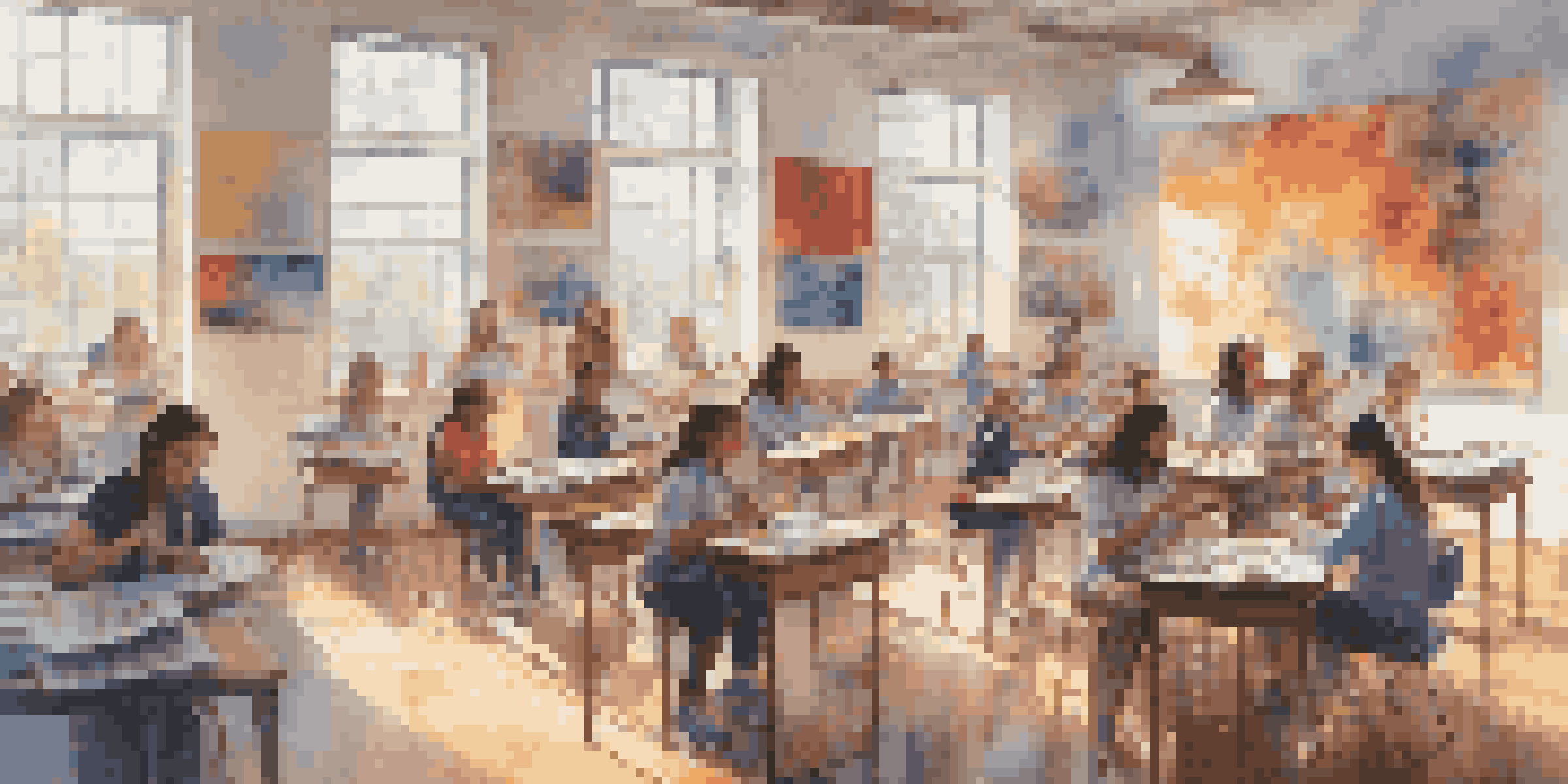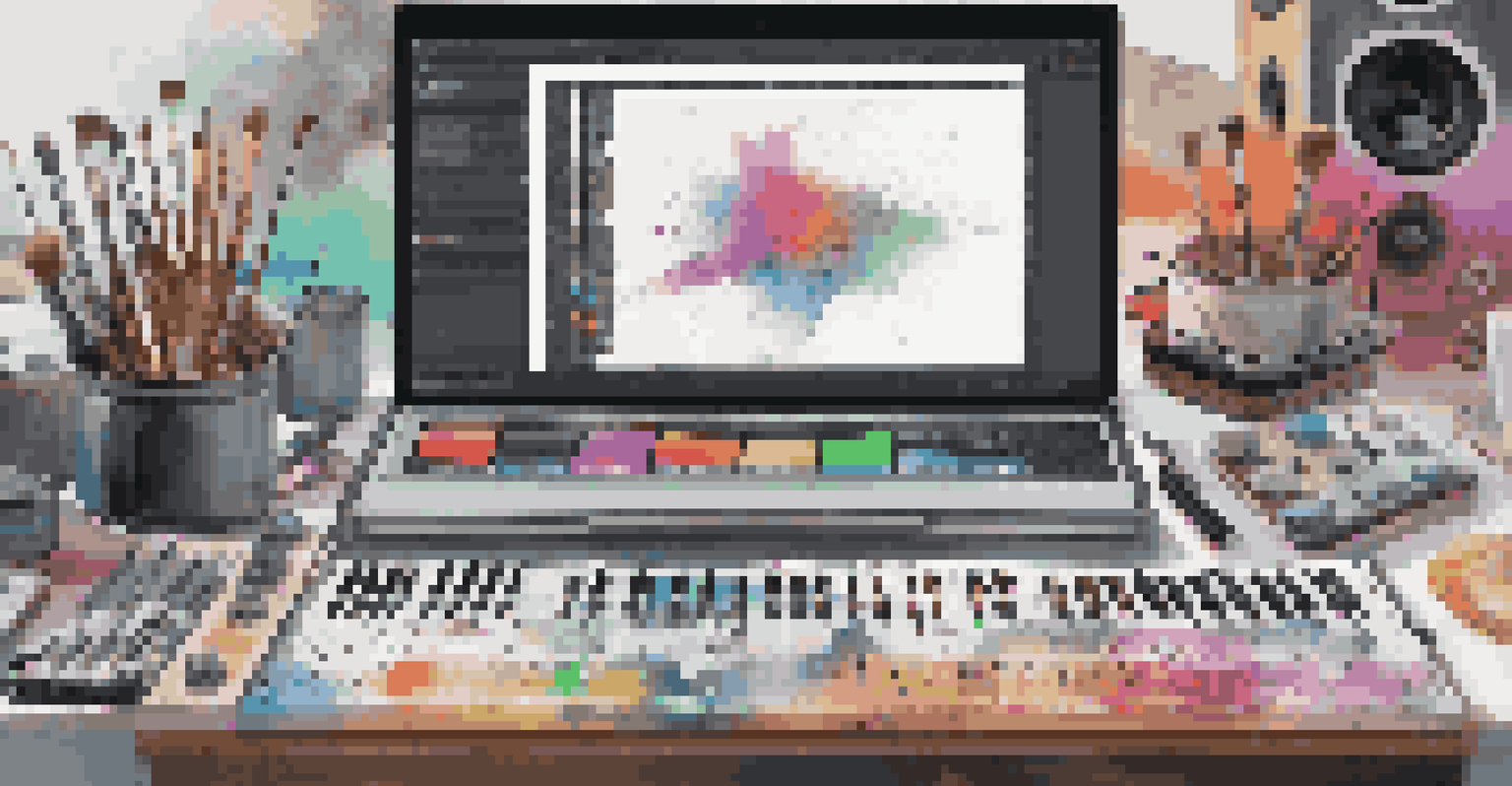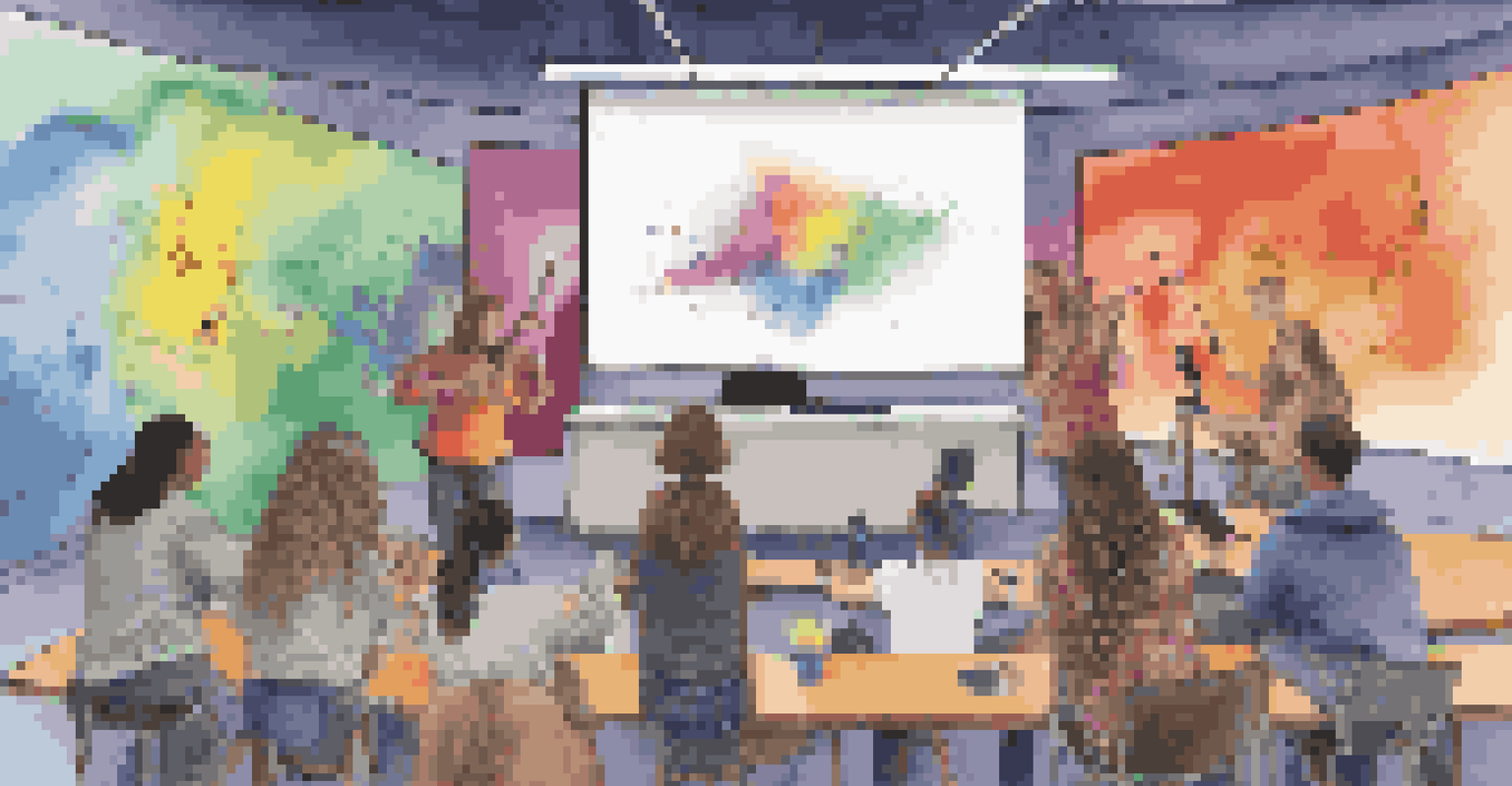Integrating Music Technology into Art Education

The Importance of Music in Art Education
Music and art have always been intertwined, each influencing the other in profound ways. When students engage with music, they tap into a world of emotion and creativity that enhances their artistic expression. For instance, a painter might find inspiration in the rhythm of a song, translating beats into brush strokes on a canvas. This synergy allows for a richer educational experience, where students can explore their creativity from multiple angles.
Music can change the world because it can change people.
Moreover, incorporating music into art classes can make learning more enjoyable and engaging. Students often find that the combination of auditory and visual elements helps them to retain information better. For example, a lesson about color theory can be paired with music that features different tempos and moods, allowing students to associate colors with specific feelings or sounds. This fusion of disciplines not only keeps students interested but also cultivates a deeper understanding of both art and music.
In essence, music serves as a powerful tool in art education, fostering emotional connections and creative thinking. By embracing this integration, educators can create a more dynamic and inspiring learning environment. As students explore the relationship between sound and visual art, they develop a holistic approach to their artistic endeavors.
How Music Technology Can Enhance Learning
The advent of music technology has revolutionized how we create and appreciate music, and this innovation can greatly benefit art education. Tools like music production software and digital audio workstations allow students to experiment with sounds and compositions in ways that were previously unimaginable. By integrating these tools into art education, students can learn about sound design while simultaneously practicing their artistic skills.

For instance, students can create their own soundtracks to accompany their visual projects, learning to synchronize music with imagery. This process not only enhances their understanding of timing and rhythm but also encourages them to think critically about how music can influence the perception of art. Imagine a student creating a multimedia presentation where their artwork is dynamically enhanced by an original score—they're not just learning to create art; they're learning to tell a story.
Music Enhances Artistic Expression
Integrating music into art education allows students to explore creativity through emotional connections and multi-sensory experiences.
Ultimately, music technology acts as a bridge between different forms of creativity, allowing students to explore their artistic voices. When they engage with these modern tools, they develop valuable skills that are applicable in various creative fields. By fostering this integration, educators can prepare their students for a future where art and technology coexist harmoniously.
Creating Collaborative Projects with Music and Art
Collaboration is a cornerstone of creativity, and integrating music technology into art education opens new avenues for students to work together. By pairing musicians and visual artists, educators can encourage students to share their unique perspectives and skills. This collaborative spirit not only enhances learning but also leads to the creation of innovative projects that blend both disciplines seamlessly.
Art is the most beautiful of all lies.
For example, a group project might involve students producing a short film where original music is composed alongside the visual storytelling. This hands-on experience allows participants to learn from each other while developing their respective crafts. The result is a rich tapestry of creativity that showcases the strengths of both musicians and artists, fostering a sense of community and shared purpose.
Through these collaborative projects, students also gain essential skills like communication and teamwork, which are vital in any creative profession. As they navigate the challenges of merging different art forms, they learn to appreciate diverse viewpoints and approaches. This not only enriches their educational experience but also prepares them for collaborative work in the real world, where interdisciplinary projects are increasingly common.
Incorporating Digital Tools into Art Lessons
Digital tools have become essential in modern education, and their integration into art lessons can enhance the learning experience. Software like Adobe Creative Suite allows students to experiment with both visual and audio elements, fostering a more hands-on approach to art creation. By using these tools, students can create digital art that incorporates sound, providing a multi-sensory experience that traditional methods may not offer.
For instance, students can design interactive art installations that respond to music or soundscapes. This not only stretches their creativity but also teaches them valuable technical skills they can use in future careers. As they learn to manipulate digital tools, they gain confidence in their abilities and discover new ways to express their artistic vision.
Technology Bridges Art Forms
Music technology enables students to experiment with sound and visuals, fostering critical thinking and innovative project creation.
In addition, integrating these digital tools helps prepare students for the evolving job market, where proficiency in technology is increasingly important. By familiarizing themselves with a range of software, students enhance their portfolios and open doors to opportunities in various creative fields. The future of art education relies on embracing these innovations to inspire the next generation of artists.
Exploring Sound as a Form of Art
Sound itself is an art form, and integrating music technology into art education allows students to explore this concept deeply. By experimenting with soundscapes, students can learn to appreciate the nuances of auditory expression. For instance, they can create sound collages that blend different musical elements, encouraging them to think of sound as a medium just like paint or clay.
This exploration can lead to a greater understanding of how sound affects mood and perception in art. Students might find that certain sounds evoke specific emotions or memories, which can influence their approach to visual art. By recognizing how sound can shape their artistic choices, they develop a more sophisticated understanding of both music and art.
As they experiment with sound as a form of art, students also learn to appreciate the work of sound artists and composers. This exposure broadens their artistic horizons and encourages them to think beyond traditional boundaries. In a world where the lines between different art forms are increasingly blurred, this exploration can spark innovative ideas and projects.
Developing Critical Thinking Through Music and Art
Integrating music technology into art education also promotes critical thinking skills, as students analyze and interpret both forms of expression. When students create art to accompany music, they must consider how each element interacts with the other. This critical engagement encourages them to question their choices and explore alternative approaches to their work.
For instance, a student may create a visual piece inspired by a particular song, prompting them to reflect on why certain colors or shapes resonate with the music. This process of introspection fosters a deeper understanding of both art and music, enabling students to articulate their creative decisions more effectively. They learn to justify their artistic choices, nurturing skills that are essential not just in the classroom but throughout life.
Collaboration Fuels Creativity
Collaborative projects that combine music and art encourage teamwork and diverse perspectives, preparing students for real-world creative challenges.
Furthermore, as students critique each other's work, they practice constructive feedback and learn to appreciate diverse perspectives. This peer interaction encourages them to look beyond their own experiences and understand how others interpret art and music. In doing so, they become well-rounded individuals who can navigate complex ideas and express themselves confidently.
The Future of Art Education with Music Technology
As technology continues to evolve, the future of art education lies in the seamless integration of music and technology. Educators must adapt their teaching methods to embrace these changes, fostering an environment where creativity can thrive. This means not only incorporating new tools but also encouraging students to explore the connections between music and art in innovative ways.
Looking ahead, we can expect to see more interdisciplinary programs that blend various art forms, allowing students to cultivate a holistic understanding of creativity. For instance, schools might offer courses that combine music production with visual arts, preparing students for careers in fields like multimedia design or film. By equipping students with a diverse skill set, we can help them succeed in an ever-changing creative landscape.

Ultimately, the goal is to inspire the next generation of artists to think outside the box and embrace collaboration across disciplines. By integrating music technology into art education, we can cultivate a vibrant community of creative thinkers who are unafraid to push boundaries. The future of art education is bright, promising a world where creativity knows no limits.